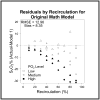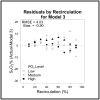Calculating mixed venous saturation during veno-venous extracorporeal membrane oxygenation
- PMID: 19948749
- PMCID: PMC2943384
- DOI: 10.1177/0267659109354790
Calculating mixed venous saturation during veno-venous extracorporeal membrane oxygenation
Abstract
Introduction: Recirculation (R), the shunting of arterial blood back into to the venous lumen, commonly occurs during veno-venous extracorporeal membrane oxygenation (VV-ECMO) and renders the monitoring of the venous line oxygen saturation no longer reflective of patient mixed venous oxygen saturation (S(V)O(2)). Previously, we failed to prove the hypothesis that, once R is known, it is possible to calculate the S(V)O(2) of a patient on VV-ECMO. We hypothesize that we can calculate S(V)O(2) during VV-ECMO if we account for and add an additional correction factor to our model for dissolved oxygen content. Therefore, the purpose of this study is to derive a more accurate model that will allow clinicians to determine S(V)O(2) during VV-ECMO when ultrasound dilution is being used to quantify R.
Methods: Using an extracorporeal circuit primed with fresh porcine blood, two stocks of blood were produced; (1) arterial blood (AB), and (2) venous blood (VB). To mimic recirculation, the AB and VB were mixed together in precise ratios using syringes and a stopcock manifold. Six paired stock AB/VB sets were prepared. Two sets were mixed at 20% R increments and 4 sets were mixed at 10% R increments. The partial pressure of oxygen (pO(2) ) and oxygen (O(2)) saturation of the stock blood and resultant mixed blood was determined. The original model was modified by modeling the residual errors with linear regression.
Results: When using the original model, as the partial pressure of arterial oxygen (P(a)O( 2)) of the stock AB increased, the calculated S(V)O(2) was higher than actual, especially at higher R levels. An iteration of the original model incorporating the P(a)O(2) level (low, medium, high) and R was derived to fit the data.
Conclusions: The original model using R and circuit saturations for the calculation of S(V)O( 2) in VV-ECMO patients is an oversimplification that fails to consider the influence of the high pO(2) of arterial blood during therapy. In the future, further improvements in this model will allow clinicians accurately to calculate S(V)O(2) in conjunction with recirculation measurements.
Figures











Comment in
-
Commentary on: Calculating mixed venous saturation during veno-venous ECMO.Perfusion. 2009 Sep;24(5):340. doi: 10.1177/02676591090240050602. Perfusion. 2009. PMID: 20051460 No abstract available.
Similar articles
-
The potential of accurate SvO2 monitoring during venovenous extracorporeal membrane oxygenation: an in vitro model using ultrasound dilution.Perfusion. 2007 Jul;22(4):239-44. doi: 10.1177/0267659107083656. Perfusion. 2007. PMID: 18181511
-
Measurements of recirculation during neonatal veno-venous extracorporeal membrane oxygenation: clinical application of the ultrasound dilution technique.J Extra Corpor Technol. 2008 Sep;40(3):184-7. J Extra Corpor Technol. 2008. PMID: 18853830 Free PMC article.
-
Improved oxygenation with reduced recirculation during venovenous ECMO: comparison of two catheters.Perfusion. 2002 Nov;17(6):415-9. doi: 10.1191/0267659102pf608oa. Perfusion. 2002. PMID: 12470030
-
The physiology of extracorporeal membrane oxygenation: The Fick principle.Perfusion. 2023 Mar;38(2):236-244. doi: 10.1177/02676591211055971. Epub 2021 Dec 27. Perfusion. 2023. PMID: 34961381 Review.
-
Cannulation for veno-venous extracorporeal membrane oxygenation.J Thorac Dis. 2018 Mar;10(Suppl 5):S606-S612. doi: 10.21037/jtd.2018.03.101. J Thorac Dis. 2018. PMID: 29732177 Free PMC article. Review.
Cited by
-
The impact of hypovolemia and PEEP on recirculation in venovenous ECMO: an experimental porcine model.Intensive Care Med Exp. 2024 Jun 1;12(1):51. doi: 10.1186/s40635-024-00636-5. Intensive Care Med Exp. 2024. PMID: 38822111 Free PMC article.
-
Effects of changes in veno-venous extracorporeal membrane oxygenation blood flow on the measurement of intrathoracic blood volume and extravascular lung water index: a prospective interventional study.J Clin Monit Comput. 2023 Apr;37(2):599-607. doi: 10.1007/s10877-022-00931-0. Epub 2022 Oct 25. J Clin Monit Comput. 2023. PMID: 36284041 Free PMC article. Clinical Trial.
-
Cannula Design and Recirculation During Venovenous Extracorporeal Membrane Oxygenation.ASAIO J. 2016 Nov/Dec;62(6):737-742. doi: 10.1097/MAT.0000000000000440. ASAIO J. 2016. PMID: 27660904 Free PMC article.
-
Venous Cannula Positioning in Arterial Deoxygenation During Veno-Arterial Extracorporeal Membrane Oxygenation-A Simulation Study and Case Report.Artif Organs. 2017 Jan;41(1):75-81. doi: 10.1111/aor.12700. Epub 2016 Apr 18. Artif Organs. 2017. PMID: 27086941 Free PMC article.
-
The Impact of Recirculation on Extracorporeal Gas Exchange and Patient Oxygenation during Veno-Venous Extracorporeal Membrane Oxygenation-Results of an Observational Clinical Trial.J Clin Med. 2023 Jan 4;12(2):416. doi: 10.3390/jcm12020416. J Clin Med. 2023. PMID: 36675344 Free PMC article.
References
-
- ELSO. ECMO registry report of the Extracorporeal Life Support Organization (ELSO) Ann Arbor, MI: 2008.
-
- Bartlett RH, Roloff DW, Custer JR, et al. Extracorporeal life support, The University of Michigan Experience. JAMA. 2000;283:904–908. - PubMed
-
- Roberts N, Westrope C, Pooboni SK, et al. Venovenous extracorporeal membrane oxygenation for respiratory failure in inotrope dependent neonates. ASAIO J. 2003;49(5):568–571. - PubMed
-
- Hartwig MG, Appel JZ, 3rd, Cantu E, 3rd, et al. Improved results treating lung allograft failure with venovenous extracorporeal membrane oxygenation. Ann Thorac Surg. 2005;80(5):1872–1879. discussion 1879–1880. - PubMed
-
- Delius R, Anderson HL, Schumacher E, et al. Venovenous compares favorably with venoarterial access for extracorporeal membrane oxygenation in neonatal respiratory failure. J Thorac Cardiovasc Surg. 1993;106:329–338. - PubMed
Publication types
MeSH terms
Substances
Grants and funding
LinkOut - more resources
Full Text Sources
Other Literature Sources

